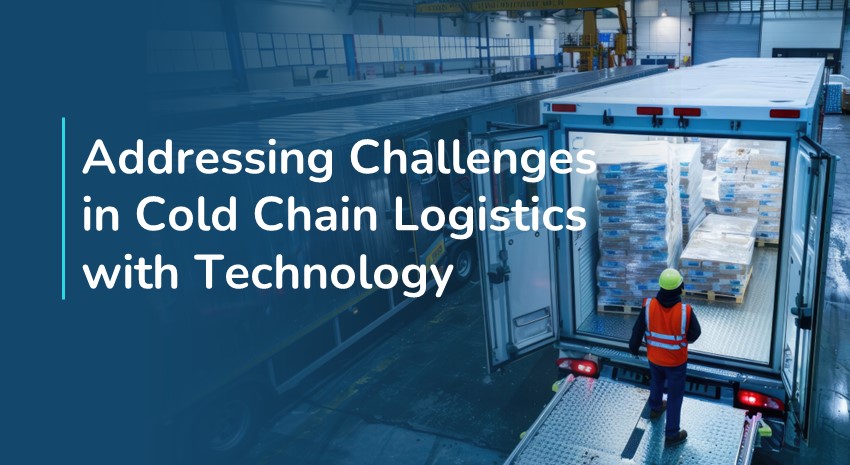Managing Cold Chain Logistics: Trends, Challenges, and Solutions for a Growing Sector

Cold chain logistics is an enormous sector that is continuing to grow, currently sitting at $249 billion worldwide and predicted to surpass $340 billion by 2031. This growth is driven by several key developments and trends that are reshaping the industry landscape and presenting both opportunities and challenges for stakeholders.
Key trends shaping the cold chain logistics sector
- Healthier eating habits: There is an increasing demand for fresh produce and seafood as consumers become more health-conscious. This trend requires cold chain logistics providers to ensure the timely and efficient delivery of perishable goods to meet the expectations of health-focused consumers.
- Changes in healthcare delivery: The rise in the utilization of temperature-sensitive products, such as biopharmaceuticals and vaccines, has created a growing need for reliable cold chain logistics. This shift in healthcare delivery methods underscores the importance of maintaining precise temperature control throughout the supply chain to ensure the efficacy and safety of these critical products.
- Transportation trends: Several transportation-related factors are influencing the cold chain logistics industry. Tighter environmental regulations are increasing costs and pushing companies toward greener practices. Additionally, tariffs and quotas in low-cost countries, coupled with a trend toward localization due to international trade barriers, are reshaping supply chains. The increasing automation in food production, driven by high labor costs, is also a significant trend, requiring logistics providers to adapt to new technologies and processes.
- Changes in freezing temperatures: Research conducted by Nomad Foods has revealed that maintaining frozen food at -15 degrees Celsius (5 degrees Fahrenheit) does not affect its quality. This finding is significant for the cold chain industry as it suggests that lowering freezing temperatures can save energy without compromising the sensory, nutritional, and textural properties of frozen food products. This trend has both environmental and economic implications, as it can lead to cost savings and a reduced carbon footprint.
Addressing challenges in cold chain logistics with technology
Despite the promising growth and emerging trends, the cold chain logistics industry faces several challenges that must be addressed for providers to remain competitive. To address these challenges and remain successful, it is essential to leverage the right technology:
Environmental sustainability
As environmental regulations become stricter, logistics providers must find ways to reduce their carbon footprint and adopt greener practices. This includes optimizing energy use, reducing emissions, and minimizing waste throughout the supply chain.
Technology can optimize route planning, energy use, and resource allocation, reducing the carbon footprint of cold chain operations. By automating processes and using data analytics, companies can minimize waste and ensure compliance with environmental regulations.
Technological advancement
The rapid pace of technological change presents both opportunities and challenges. To enhance efficiency and maintain competitiveness, cold chain logistics providers must invest in new technologies, such as automation and advanced monitoring systems. However, the cost of implementing these technologies can be a significant barrier for some companies.
Technology can facilitate the adoption of new technologies by integrating them into existing systems and processes. This ensures that logistics providers can stay ahead of the curve and maintain a competitive edge in a rapidly changing industry.
Cost management
The rising costs associated with transportation, tariffs, and labor pressure cold chain logistics providers. To remain profitable, companies must find ways to manage these costs effectively while maintaining high standards of service.
Technology can help logistics providers manage costs by improving efficiency, reducing waste, and optimizing resource allocation. Advanced analytics can identify cost-saving opportunities and streamline operations, allowing companies to remain profitable despite rising expenses.
Regulatory compliance
As the demand for temperature-sensitive products like biopharmaceuticals and vaccines grows, so too does the need for strict regulatory compliance. Cold chain logistics providers must ensure that their processes meet all relevant regulations to avoid costly fines and ensure the safety and efficacy of the products they transport.
Technology can also play a critical role in ensuring regulatory compliance. By automating monitoring and reporting processes, logistics providers can ensure that they meet all relevant regulations and maintain the integrity of temperature-sensitive products throughout the supply chain.
Contact ArcherPoint to learn how you can prepare your company to take advantage of the trends taking place in cold chain logistics.
Trending Posts
Stay Informed
Choose Your Preferences
"*required" indicates required fields
